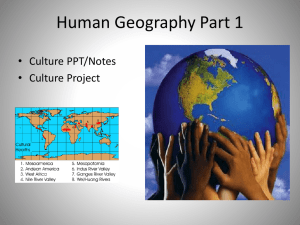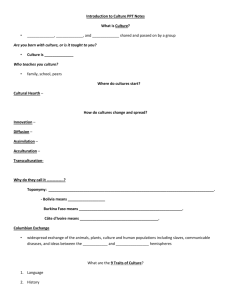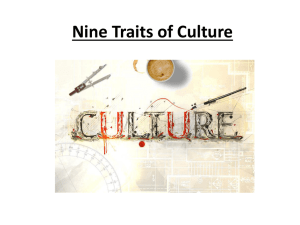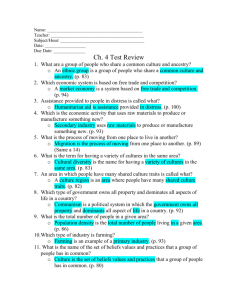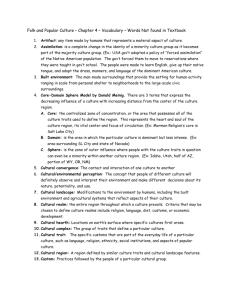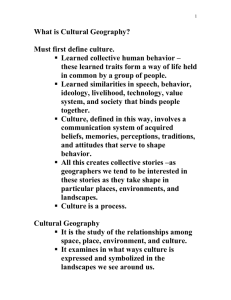Intro to Culture/Human Geography
advertisement
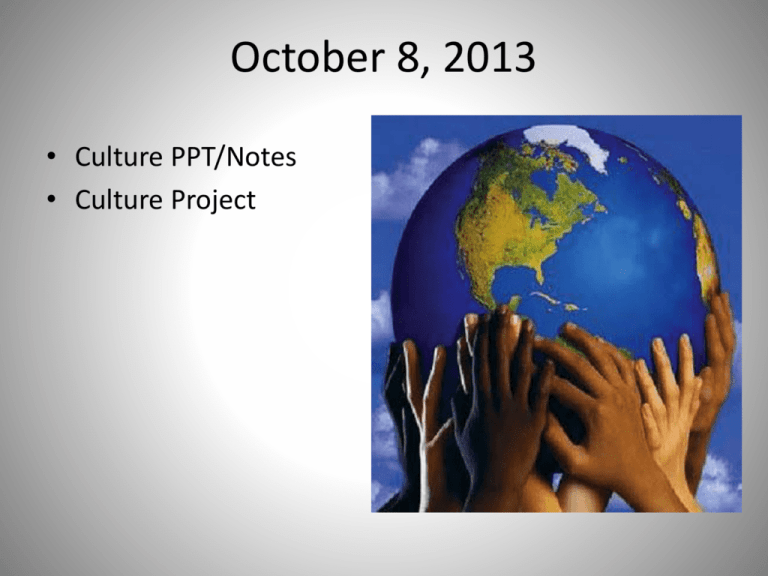
October 8, 2013 • Culture PPT/Notes • Culture Project What is Culture? • Knowledge, attitudes, and behaviors shared and passed on by a group Are you born with culture, or is it taught to you? • Culture is learned Who teaches you culture? • family, school, peers What things do we share as – Humans? – Americans? – Texans? Where do cultures start? • Cultural Hearth – where innovations, ideas, materials and technology begin How do cultures change and spread? • Innovation – creating something new to meet a need. • Diffusion – spread of ideas, inventions, or patterns of behavior • Assimilation – smaller society adopts the culture of a majority group • Acculturation – society accepts or adopts an innovation • Transculturation (a term coined by Cuban anthropologist Fernando Ortiz in 1947) -- : a process of cultural transformation marked by the influx of new culture elements and the loss or alteration of existing ones Why do they call it……………..? • Toponymy is the scientific study of place names (toponyms), their origins, meanings, use and typology. – Examples: Bolivia (South America): "Land of Bolivar" in New Latin, in honor of Simón Bolívar, one of the leading generals in the Spanish American wars of independence. Burkina Faso (Africa): "Land of Honest Men", More burkina ("honest", "upright", or "incorruptible men") and Dioula faso ("father's house") Côte d'Ivoire (Africa): "Ivory Coast" in French, from its previous involvement in the ivory trade. For more go to: http://en.wikipedia.org/wiki/List_of_country-name_etymologies • Columbian Exchange – widespread exchange of the animals, plants, culture and human populations including slaves, communicable diseases, and ideas between the Eastern and Western hemispheres What culture did America adopt these things from? • Hot Dogs + Hamburgers – German • Chocolate – Aztec • Democratic Government – Greek • Halloween – Celtic • Number system – Hindu-Arab • Hockey – Canadian • Paper Money – Chinese Examples - How do cultures change and spread? Cultural Diffusion – Real Life Example • The blues originated in the “field hollars” of southern slaves. • The ancient African call-and-response pattern is the core of the blues. • Recordings of early artists from the 1920’s and 30’s reached Europe before World War II. • Cultural Diffusion! Blues Diffusion Robert Johnson • Traveling Riverside Blues – Recorded in 1937 Led Zeppelin • Traveling Riverside Blues – Recorded in 1969 Blues Diffusion Howlin’ Wolf • Back Door Man – 1961 The Doors • Back Door Man – 1967 What are the 9 Traits of Culture? 1. 2. 3. 4. 5. 6. 7. 8. 9. Language History Religion (beliefs / morals / mores) Food and Shelter (Types / Styles) Education Systems Security/Protection Relationships – Family and Others Political and Social Organizations Creative Expression - Recreation 1. Language • Allows for communication to exist • There are between 3,000 and 6,500 different languages spoken in the world today! • Helps establish cultural identities • Can divide people – Canada - French/English • Oral tradition - Helps pass cultural traits along through generations • Dialect – different versions of the same basic language – “You all” vs. “ya’ll” vs. “you guys” • Language Diffusion – Follow trade routes – Blend from other languages – Migration 2. History • What do you know or want to know about your ancestors? - What part(s) of the world are they from? What were they like? What obstacles did they have to overcome? What effect does your family history have on your current life? • Ancestry is the descendancy of a person’s bloodlines. • Genealogy is the research and analysis of ancestry. • People worldwide engage in genealogy as hobbyists or professionals, often with the goal of determining their ethnic origin, discovering the truth about a family legend, indulging a passion for history or for the purpose of learning more about a family’s health history. • Read more: http://www.ehow.com/about_6696282_genealogy-vs_-ancestry.html#ixzz2h8w7GBk1 3. Religion Major world religions • • • • • • Christianity - 33% Islam - 21% Hinduism - 14% Buddhism - 6% Judaism - .2% Others -25% Morals - How we should act (eg. Your conscience) Mores - Customs and rules of conduct; (eg. rules of the road) What is religion? • The belief in a supernatural power or powers, responsible for the creation and maintenance of the universe Types of Religions? 1. Monotheistic – belief in one god 2. Polytheistic – belief in many gods 3. Animistic or Traditional – belief in the forces of nature 4. Food and Shelter – The places we live and the things we eat 5. Education - How culture is taught or learned Formal – Schools, Universities, Religion (church) In-Formal – Family, Friends, Social Clubs / Groups 6. Security/Protection • Military – National Govt. • Police – Local Govt. • Family - Tribe 7. Relationships – Family and Others • Family • Friends • Classmates / Co-Workers 8. Political and social organization • Government System – Make rules and laws to keep society in order • Clubs – Examples? Boys and Girls, Boy Scouts, FFA, Optimists, • Fraternal organizations – Kiwanis, University, Veterans, Masonic etc. 9. Creative Expression - Recreation • Music – instruments, singing • Art – Paintings, sculpture, photography • Dance • Theater • Literature – Novels, Poems • Architecture • Sports • Outdoor activities • Hobbies • How are cultural regions organized? Society • • a group that shares a geographic region, a sense of identity and a culture Ethnic groups - a specific group within a society that shares a common language, customs, and heritage • • Race (biological) refers to a person's physical appearance, such as skin color, eye color, hair color, bone/jaw structure etc. Ethnicity (sociological) relates to cultural factors such as nationality, culture, ancestry, language and beliefs. Your Family Culture Create a graphic organizer (similar to the one below) using the 9 Traits of Culture and list at least 2 examples from the 9 Traits of Culture using your family. Language Creative Expression – Recreation History Religion – Beliefs Morals and Mores Political and Social Organizations 9 Traits of Culture Relationships – Family Structure - Others Security and Protection Food and Shelter Education – Formal and Informal
